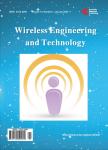Rain Attenuation in the Microwave-to-Terahertz Waveband
Rain Attenuation in the Microwave-to-Terahertz Waveband作者机构:Department of Information Networks National Institute of Technology Sendai College Sendai Japan Department of Communication Engineering National Defense Academy Yokosuka Japan
出 版 物:《Wireless Engineering and Technology》 (无线工程与技术(英文))
年 卷 期:2016年第7卷第2期
页 面:59-66页
学科分类:0809[工学-电子科学与技术(可授工学、理学学位)] 08[工学]
主 题:Terahertz Wave Microwave Rain Attenuation Weibull Distribution ITU-R
摘 要:In recent years, there has been increased interest in the terahertz waveband for application to ultra-high-speed wireless communications and remote sensing systems. However, atmospheric propagation at these wavelengths has a significant effect on the operational stability of systems using the terahertz waveband, so elucidating the effects of rain on propagation is a topic of high interest. We demonstrate various methods for calculating attenuation due to rain and evaluate these methods through comparison with calculated and experimental values. We find that in the 90 - 225 GHz microwave band, values calculated according to Mie scattering theory using the Best and P-S sleet raindrop size distributions best agree with experimental values. At 313 and 355 GHz terahertz-waveband frequencies, values calculated according to Mie scattering theory using the Weibull distribution and a prediction model following ITU-R recommendations best agree with experimental values. We furthermore find that attenuation due to rain increases in proportion to frequency for microwave-band frequencies below approximately 50 GHz, but that there is a peak at around 100 GHz, above which the degree of attenuation remains steady or decreases. Rain-induced attenuation increases in proportion to the rainfall intensity.



